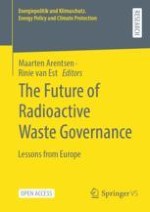This Open Access book examines the radioactive waste management policies of ten European countries: Belgium, Finland, France, Germany, Italy, the Netherlands, Spain, Sweden, Switzerland and the United Kingdom. Most countries are in the process of planning and creating final storage solutions, while none has yet finalized this process. Over the past decades many countries have been renewing their decision-making processes and the institutions that support them. The book provides 16 lessons that may advance the future democratic decision-making process around radioactive waste management.
